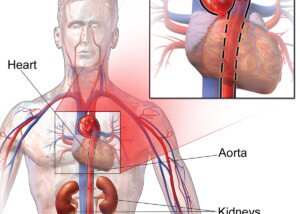
A vascular surgeon explains the reasons why stent grafts are not the solution for ascending aortic aneurysms.
Perhaps you already know that stent graft repair of descending and abdominal aortic aneurysm is the repair procedure of choice for select patients.
I didn’t understand, then, why stent graft repair was apparently impossible with an aneurysm of the ascending aorta.
I thought maybe it had something to do with not being able to “feed” the catheter over the arch of this great vessel. Well, that’s hardly the reason.
Stent graft repair is also known as endovascular repair. The issue with “endo stenting” of the ascending portion of the aorta is the length of this section; it’s too short, says Seyed-Mojtaba (Moji) Gashti, MD, a board certified vascular surgeon with Broward Health Medical Center in Florida.
Endovascular repair of the ascending aorta, to my surprise, is actually being done, says Dr. Gashti, but only for select patients, mostly at the Arizona Heart Institute.
He explains, “For endo stenting to work, you have to have adequate ‘landing zones.’ What this means is that you have to have ‘normal’ aorta both proximal and distal to the diseased (aneurysmal) area so that you get a good seal.”
Proximal and distal mean, in layman’s terms, on both ends of the aneurysm.
Without that good seal, a leak (called an endoleak) will occur, and the aneurysm will continue to be pressurized: a bad thing.
Dr. Gashti explains, that when he does a “TEVAR or EVAR (endo graft for thoracic aortic aneurysm and abdominal aortic aneurysm), a minimum of 20 millimeters of normal aorta is needed both proximal and distal to the aneurysm,” meaning, on either side.
The portion of the aorta that’s inside the heart is called the root. Attached to this area are the coronary arteries that feed blood to the heart.
These coronary arteries are the first branches (closest to the heart itself) of the ascending portion of this great vessel.
These first branches absolutely cannot be covered by the stent graft. After all, the stents are covered-type stents, not the bare metal type.
At the other “end” of the ascending aorta (the distal end) are branch-offs, or takeoffs, of the subclavian and carotid arteries.
Dr. Gashti says you certainly don’t want these to get covered by stent material, either.
“So by the time you add the landing zones and branches, not much room is left,” he says.
If you can visualize this scenario, it’s easy to see why stent grafting just won’t work for ascending aortic aneurysms — elongated aneurysms, that is.
“But for very focal aneurysms and particularly if they are saccular rather than fusiform, it is being done.”
- Fusiform is an elongated, more uniform bulge all around the great vessel’s circumference.
- A saccular bulge looks like a sack protruding from one side of the vessel.
Saccular can also mean a protrusion of short width encircling the vessel — imagine an expandable rubber tube the diameter of a dime, but at some point five nickels are stacked together inside it; imagine the shape this would cause to the tube.
Dr. Gashti continues, “The other problem is the aortic pressures that you have to deal with at the time of deployment — so close to the left ventricle — which will push your device away from the intended location; so these procedures usually require cardiac arrest at the time of deployment.”
In other words, the heart must be stopped for the surgeon to position the stent, and this means use of a heart-lung machine (cardiopulmonary bypass).
So now you know why stent grafting, as of 2014 when this article was published, is not a practical option for the repair of an ascending aortic aneurysm.
Update As of 2025: Stent Grafting in the Ascending Portion
- Stent grafts can be done in the ascending portion for an aortic aneurysm.
- However, stent placement here is complex and still in the experimental realm.
- The procedure is usually reserved for high-risk patients.
- The procedure involves a very customized, fenestrated or branched stent graft — and “debranching” of major arteries may be required. These arteries supply blood to the brain and arms.

Dr. Gashti specializes in the diagnosis and treatment of vascular disease including abdominal and aortic aneurysm. He received his medical degree from University of New England College of Osteopathic Medicine and has been in practice for more than 20 years.
 Lorra Garrick has been covering medical, fitness and cybersecurity topics for many years, having written thousands of articles for print magazines and websites, including as a ghostwriter. She’s also a former ACE-certified personal trainer.
Lorra Garrick has been covering medical, fitness and cybersecurity topics for many years, having written thousands of articles for print magazines and websites, including as a ghostwriter. She’s also a former ACE-certified personal trainer.
.









































